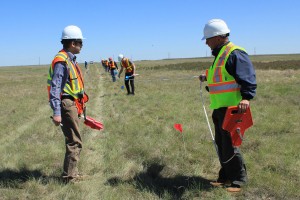A team of researchers from Lawrence Berkeley National Laboratory (LBNL) will test three monitoring technologies at CMC’s Field Research Station in early 2016.
Tom Daley, Head of the Geophysics Department at LBNL, and a team comprising three scientists and two technicians will be installing novel subsurface monitoring equipment in collaboration with CMC researchers. The US$350,000 project, which was funded by the U.S. Department of Energy’s Carbon Storage Program, will help determine which methods are most effective in detecting CO2 should it migrate out of its containment reservoir. The technology includes fiber-optic sensors for seismic and thermal monitoring, electromagnetic imaging tools, and downhole geochemical samplers.
The Field Research Station (FRS) is being developed by CMC in collaboration with the University of Calgary to develop and improve technologies for monitoring the migration of gas, particularly CO2, at shallow to intermediate depths. When the first stage of construction is complete in 2016, the site will comprise one 300 m well for CO2 injection, two dedicated monitoring wells, and four shallow water-monitoring wells.
International collaboration demonstrates value
“International research collaboration, particularly with internationally renowned scientists from LBNL, illustrates the significance and value to Alberta of research at the FRS,” says Dr. Don Lawton, Director of CMC’s Containment and Monitoring Institute and Professor of Geophysics at the University of Calgary.
For decades, energy companies have been pumping CO2 into nearly depleted reservoirs to increase pressure and extract more oil and gas. This experience has provided a solid understanding of how CO2 behaves when it’s stored at depths of two or three kilometres. What remains a mystery is how CO2 will behave if it escapes from a reservoir and begins to migrate upwards.
Field research tests models
“We aren’t 100 per cent certain that we understand everything that will happen,” says Daley. “We have models, we have theories, we have previous measurements, but we often have some things that surprise us. That’s why we are doing these field experiments.”
CO2 can exist in four states: solid, liquid, gas and, at high pressure and temperature, supercritical where it has the properties of both a gas and a liquid. In deep storage sites, CO2 is in a supercritical state. If it breaches containment and begins to rise to the surface, at some point it will change phase into a gas.
“And what you are doing at the field research station,” says Daley, “is an experiment to look at the ability to monitor CO2 when it’s in this gas state, as it would be if it migrated out of a storage reservoir.
A unique facility
“As far as I know in the carbon capture and storage research and development world this is a unique experiment and that’s a big reason for us to collaborate with CMC.”
The three separate monitoring tasks planned by Daley and LBNL staff scientists Barry Freifeld and Mike Wilt will be conducted before and after CO2 is injected. After the work is completed, some monitoring equipment will be left down-hole at the site and will be available to other researchers.
Each of the technologies brings something unique to the site. For instance, Daley will implement a seismic crosswell survey, which will use two boreholes to probe the interwell region in order to image the CO2 plume. This technology has a higher spatial resolution than other seismic methods which should make the plume easier to see.
The surface-to-borehole electromagnetic survey will use CMC’s recently purchased electrical resistivity tomography array and LBNL’s own downhole equipment to map the background resistivity structure and the CO2 plume.
Simultaneous measurement of well
The borehole fibre optic experiment involves using a copper wire to heat the well and then watching the temperature decay using the fibre cable. Different fluids, water vs CO2 for example, carry different amounts of heat so researchers will be able to observe the distribution of CO2 in the reservoir.
“The beauty of this technology is that it measures the entire well simultaneously . . . you can continuously record the temperature on the fibre at every depth,” says Daley.
The team will also install a novel fluid sampling device designed by Freifeld. The U-tube uses a loop of high pressure tubing with a down-hole check valve to collect fluid samples. Compressed gas then forces the water back to the surface for analysis.
“Wireline fluid samplers are the usual method to sample water in deep wells. However the process can take hours and the cost of running the specialized equipment can be quite high. The U-tube is permanently deployed and can quickly bring samples back to the surface whenever desired.” says Daley.
Researchers push limits
The U-tube is also located on the outside of the well casing – so the well is not blocked to other equipment. In fact, says Daley, this is a key part of the research in which he and Freifeld are engaged.
“In an oilfield or other borehole cable operation you might have two or three tools stacked together but there is a limit to what you can do. We are looking at how you can do these multiple measurements with permanent installations with multiple cables on the pipe,” says Daley.
Daley is not yet sure how long he and his colleagues will work at the station because budgets have not been set for coming years. But he is certain that, despite an increasing global focus on the development of renewables and energy efficiency, work at the field research station is critical to achieving a low carbon future.
“As I understand the world’s CO2 emissions and what we need to do to get into a reduced or zero emissions future, storing the CO2 that’s generated by burning fossil fuels and other industrial activities really is a necessary part of it.”
